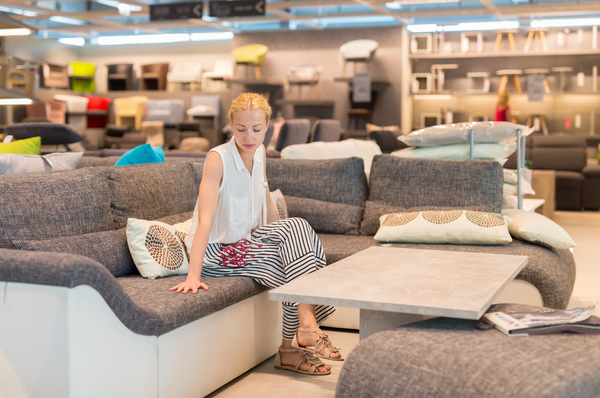Buying furniture is both exciting and overwhelming. You have so many choices these days–and the process of purchasing one has never been simpler. But maybe this is where the problem starts and why so many people end up making mistakes when buying furniture.
Because of the array of options, it's easy to make impulsive purchases without thinking about the potential pitfalls. There is always a looming possibility of making expensive mistakes. Of course, you'd want to avoid them especially since you're shelling out a considerable investment.
But you can avoid furniture-buying blunders when you're armed with information. In this article, we will explore the most common pitfalls and biggest mistakes when purchasing furniture. We want to help you make informed decisions and ensure that your next furniture hunt is a success.
Choosing price over value
Everyone loves a bargain, especially when it comes to furniture. So, it's no surprise that choosing price over value is a common mistake.
As you know well, furniture tends to be pricier than other home items. But when you stumble upon a discounted gem or a downright jaw-dropping price, it's practically instinct to pounce on that "rare" opportunity.
But you might want to calm down first before making a move. Imagine buying a bed frame. One made from natural solid wood might cost more than the much cheaper one you're eyeing from that big retail store. But what about its quality? Will this piece of furniture last? Will it fall apart soon and need constant repairs? Remember that repairs and replacement costs can add up over time and suddenly that "great deal" becomes a money pit.
When evaluating price, it is important to consider the value. So, think beyond just the sticker price, however tempting it may be. Consider the furniture's cost of ownership over its expected life. Try not to fall for the trap of short-term savings that will cost you in the long run.
Failing to measure
Not measuring your space or failing to measure well enough is an all too common mistake when buying furniture. And there’s nothing worse than dropping some serious dough on a brand-new piece of furniture plus delivery fees—only to discover it won’t fit through your doorway.
Prevent this massive mistake by making sure you have taken all the measurements necessary before you head to the store. Ensure that you get all the figures right for the room, doorways, stairwells, and elevators. Also, factor in tight corners and any fixture that might obstruct getting the furniture in a room.
And, of course, don’t forget to measure the furniture itself before you buy—showrooms can make furniture look deceptively deep or tall, and you don’t want any last-minute surprises.
Ignoring scale
Aside from accurately measuring your space, make sure to consider the scale, too.
Choosing furniture pieces without considering the room size can throw off everything. Imagine a massive couch dwarfing a cozy living room, making it feel cramped and uncomfortable. On the other hand, tiny armchairs in a grand hall leave awkward empty spaces and a disjointed vibe.
Remember that scale is key for visual balance and functionality. Proper scale maximizes space, allows traffic flow, and creates a cohesive, inviting atmosphere. Furniture serves both form and function and getting the scale right makes your space both aesthetically pleasing and comfortable to live in.
Trend-chasing
Chasing trends when buying furniture can be a costly and fleeting mistake.
Buying trendy furniture can be risky. These pieces can quickly go out of style. You might find yourself stuck with an outdated piece that no longer reflects your style or home's aesthetic. Not only that, but trendy furniture is often poorly made. Many manufacturers prioritize style over quality, leading to rushed production and the use of substandard materials. As a result, these pieces don't stand the test of time.
When you follow trends, you tend to disregard your unique taste and preference. To make your space truly a home, it should be a reflection of your identity, not a mere copy of what's popular. So, invest in furniture that you truly adore and that enhances your current style (and that you can foresee using even if your style evolves).
Buying on impulse
Have you ever purchased a piece of furniture only to realize it doesn't fit right or doesn't match your existing decor? This is what often happens when we get swayed by our impulse when buying furniture.
Buying furniture on impulse can be a costly faux pas for several reasons. First, you risk ignoring crucial factors like fit and function. That gorgeous armchair might look stunning in the store, but it might overwhelm your living room or clash with your existing decor.
Second, impulse purchases often disrupt your budget, potentially leaving you financially strained or compromising on other needs. Lastly, you neglect the importance of considering quality and value. A flashy deal might tempt you, but opting for sturdy, well-crafted pieces ultimately save you money and frustration in the long run.

Compromising comfort for look
Sacrificing comfort for style is a surefire way to create a room that's as aesthetically pleasing as it is physically punishing. Imagine a sleek, ultra-modern sofa that looks stunning in your magazine-worthy living room but leaves you with an aching back after a mere ten minutes.
When choosing furniture, always consider your lifestyle and individual needs before style. You wouldn't want to end up with poorly designed furniture that triggers chronic back pain, muscle tension, and even injuries.
Remember, furniture isn't just decoration, it's an investment piece for your well-being.
Ignoring your budget
Ignoring your budget when buying furniture is a recipe for financial stress. Furniture is a big-ticket item, and exceeding your budget can lead to hefty debt and potentially high-interest loans. Those monthly payments could strain your finances for months, and even years.
So, set a budget and stick to it to curb impulse buys. With a clear limit, you're protecting yourself from being swayed by sales pitches and falling in love with an expensive piece of furniture you can't realistically afford.
Thinking beyond the initial purchase, note that furniture purchases often come with additional, hidden costs like delivery, assembly, or taxes. A responsible budget plan also considers long-term maintenance and potential replacements. Furniture may need periodic updates or repairs, and having some financial leeway ensures you can manage these costs well.
Not asking for help
Getting help from a salesperson or designer can make furniture shopping easier. With their extensive knowledge of furniture (some are even experts at optimizing space), they can help you choose furniture that maximizes functionality and fits your style.
They're also your budget confidantes. With their help, you navigate price points, identify hidden costs like delivery and assembly, and even discover financing options so you can stay within your financial comfort zone.
So while shopping solo in a furniture store may sound appealing to you, it also won't hurt to ask for assistance. Who knows what surprises you might enjoy by asking for assistance from experts?
...
Whether you're furnishing a new home or simply looking to refresh your space, it's important to familiarize yourself with and avoid the biggest mistakes when buying furniture. By being aware of these common pitfalls, you can secure yourself some fabulous pieces of furniture that truly fit your space and serve your home for a long time.



Leave a comment
This site is protected by hCaptcha and the hCaptcha Privacy Policy and Terms of Service apply.